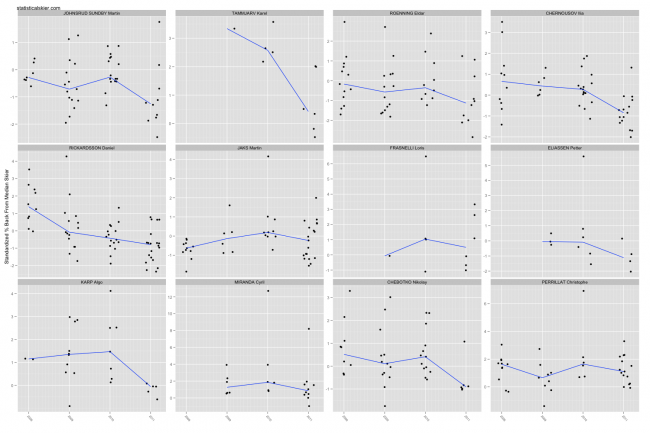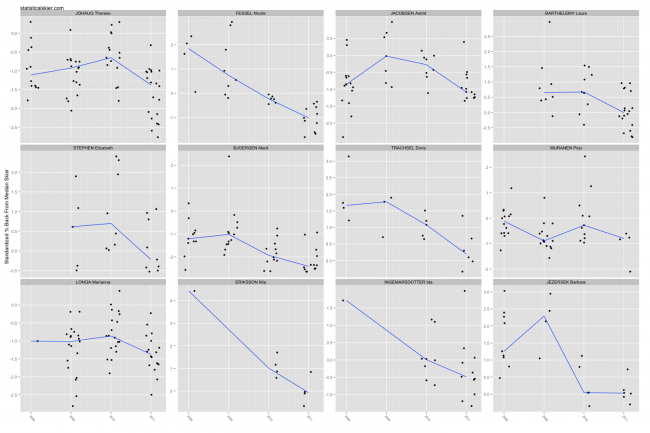Last year I took a very simplistic approach toward identifying skiers who’d made strong gains (or losses) in their performance over the previous season. This year I thought I’d do something a bit more sophisticated.
Anyone paying attention to the WC field can probably list some skiers who skied considerably faster or slower this year compared to last. The fun part of doing this numerically is that it can provide a bit of objectivity to the matter and also identify some skiers we might not have thought of. In the case of distance events, I now have an embarrassingly large number of ways to evaluate performance: rank, FIS points, percent back from median skier, etc. Last year I used FIS points, but this year I thought I’d satisfy everyone by using all of them.
So what I did was take skiers who’ve done at least four races both this season and last season and measured the change in the their performance using rank, FIS points and percent back from the median skier. I adjusted the change by each measure relative to their performance last season. This means that improving from 80 FIS points to 40 FIS points is considered an equivalent improvement to 20 FIS points to 10 FIS points. This helps prevent the better skiers from being unfairly penalized. The following two graphs show the 12 athletes (1-12 top-bottom, left-right) that saw the biggest improvements across all three measures.
I’ve only displayed the previous four seasons worth of results, so that it’s a bit easier to see the detail of just the last two. But be aware that I plotted each athlete with their own y-axis, so don’t be tricked into trying to compare different athletes to each other. And obviously I”ve only graphed the results using one of the measures used to rank the skiers.
When looking at these, remember that there are several of ways your results can improve. Your best results could be better (Martin Jaks or Daniel Rickardsson), or you could have fewer bad results (Pirjo Muranen), or you could just improve across the board (Ilia Chernousov).
Muranen kind of sneaks into this list thanks to her doing many fewer races this year, none of which were particularly slow. But if we’re being fair she really probably didn’t ski any faster this year. Therese Johaug and Nicole Fessel are obvious choices and quite deserving of the 1-2 spots. Astrid Jacobsen also had a strong season, but she probably didn’t get as much press thanks to the exploits of Johaug and Bjørgen. Speaking of Bjørgen, who’d of thought that after her 2009-2010 season she’d make a “most improved” list? But I think we can all admit that she really did ski this fast, which is slightly unbelievable. If she makes this list again next year, I think my head will explode, as will nearly every head in Poland.
Some surprising names? Who’d have thought that American Liz Stephen would be 5th on this list? I think she’s been helped out somewhat by the fact that her results in 2009-2010 were a bit below par, so her improvement is over a somewhat bad season. Laure Barthelemy is another skier who doesn’t get a ton of press, but she had a much stronger season, cracking the top 30 eleven times.
On the men’s side, Karel Tammjarv (EST) is another name probably not well known. His results on the WC circuit weren’t great this season, but they were much improved. And of course he did win a Scandinavian Cup race and was 9th at U23s this year.
Both Martin Johnsrud Sundby and Eldar Rønning skied considerably better this year, which may have helped to ease Norway’s concerns about their men’s distance squad. If you consider that they are both under 30 (although not by much) and include youngsters like Sjur Roethe and Finn Hagen Krogh, the Norwegian men’s distance team may be quite strong next year.
Ilia Chernousov had, quite frankly, a stunningly good season. Last year, about half of Chernousov’s races were in the top 30. These year, all but one of them were in the points. Last year, Chernousov cracked the top ten twice. This year? Seven times. He doubled his podium count over last year (4 vs 2) and that included two wins. While looking over his results, I noticed something interesting, though. He seemed to change his focus this year to mostly freestyle races and pursuits. Last year, he did 7/10 classic races; this year he did only 3/8. I don’t think he’s dramatically better at skating (at least, it doesn’t show up strongly in his results), but it’s an interesting shift.
Martin Jaks had a strong showing this year, although that is almost entirely due to his results from the Tour de Ski. Three of his four top 10 results came in the Tour, but other than that he was typically in the 15th-25th zone.
[ad#AdSenseBanner]


{ 1 } Comments